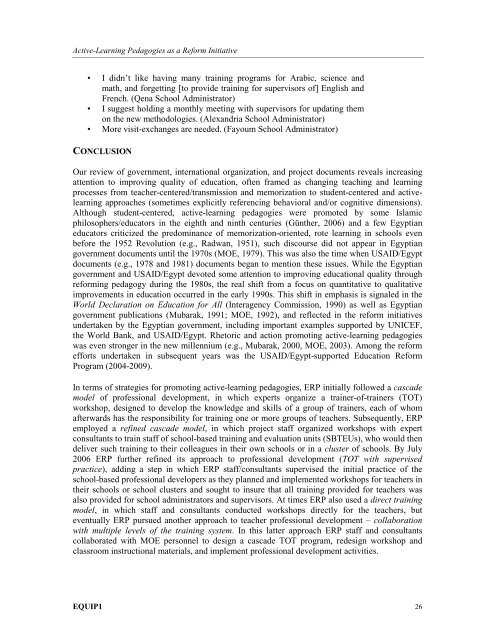Active-Learning Pedagogies as a Reform Initiative ... - EQUIP123.net
Active-Learning Pedagogies as a Reform Initiative ... - EQUIP123.net
Active-Learning Pedagogies as a Reform Initiative ... - EQUIP123.net
You also want an ePaper? Increase the reach of your titles
YUMPU automatically turns print PDFs into web optimized ePapers that Google loves.
<strong>Active</strong>-<strong>Learning</strong> <strong>Pedagogies</strong> <strong>as</strong> a <strong>Reform</strong> <strong>Initiative</strong>• I didn’t like having many training programs for Arabic, science andmath, and forgetting [to provide training for supervisors of] English andFrench. (Qena School Administrator)• I suggest holding a monthly meeting with supervisors for updating themon the new methodologies. (Alexandria School Administrator)• More visit-exchanges are needed. (Fayoum School Administrator)CONCLUSIONOur review of government, international organization, and project documents reveals incre<strong>as</strong>ingattention to improving quality of education, often framed <strong>as</strong> changing teaching and learningprocesses from teacher-centered/transmission and memorization to student-centered and activelearningapproaches (sometimes explicitly referencing behavioral and/or cognitive dimensions).Although student-centered, active-learning pedagogies were promoted by some Islamicphilosophers/educators in the eighth and ninth centuries (Günther, 2006) and a few Egyptianeducators criticized the predominance of memorization-oriented, rote learning in schools evenbefore the 1952 Revolution (e.g., Radwan, 1951), such discourse did not appear in Egyptiangovernment documents until the 1970s (MOE, 1979). This w<strong>as</strong> also the time when USAID/Egyptdocuments (e.g., 1978 and 1981) documents began to mention these issues. While the Egyptiangovernment and USAID/Egypt devoted some attention to improving educational quality throughreforming pedagogy during the 1980s, the real shift from a focus on quantitative to qualitativeimprovements in education occurred in the early 1990s. This shift in emph<strong>as</strong>is is signaled in theWorld Declaration on Education for All (Interagency Commission, 1990) <strong>as</strong> well <strong>as</strong> Egyptiangovernment publications (Mubarak, 1991; MOE, 1992), and reflected in the reform initiativesundertaken by the Egyptian government, including important examples supported by UNICEF,the World Bank, and USAID/Egypt. Rhetoric and action promoting active-learning pedagogiesw<strong>as</strong> even stronger in the new millennium (e.g., Mubarak, 2000, MOE, 2003). Among the reformefforts undertaken in subsequent years w<strong>as</strong> the USAID/Egypt-supported Education <strong>Reform</strong>Program (2004-2009).In terms of strategies for promoting active-learning pedagogies, ERP initially followed a c<strong>as</strong>cademodel of professional development, in which experts organize a trainer-of-trainers (TOT)workshop, designed to develop the knowledge and skills of a group of trainers, each of whomafterwards h<strong>as</strong> the responsibility for training one or more groups of teachers. Subsequently, ERPemployed a refined c<strong>as</strong>cade model, in which project staff organized workshops with expertconsultants to train staff of school-b<strong>as</strong>ed training and evaluation units (SBTEUs), who would thendeliver such training to their colleagues in their own schools or in a cluster of schools. By July2006 ERP further refined its approach to professional development (TOT with supervisedpractice), adding a step in which ERP staff/consultants supervised the initial practice of theschool-b<strong>as</strong>ed professional developers <strong>as</strong> they planned and implemented workshops for teachers intheir schools or school clusters and sought to insure that all training provided for teachers w<strong>as</strong>also provided for school administrators and supervisors. At times ERP also used a direct trainingmodel, in which staff and consultants conducted workshops directly for the teachers, buteventually ERP pursued another approach to teacher professional development – collaborationwith multiple levels of the training system. In this latter approach ERP staff and consultantscollaborated with MOE personnel to design a c<strong>as</strong>cade TOT program, redesign workshop andcl<strong>as</strong>sroom instructional materials, and implement professional development activities.EQUIP1 26
















